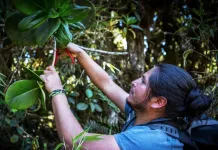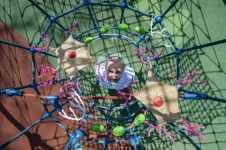(Press-News.org) ADELPHI, Md. -- Spoken dialogue is the most natural way for people to interact with complex autonomous agents such as robots. Future Army operational environments will require technology that allows artificial intelligent agents to understand and carry out commands and interact with them as teammates.
Researchers from the U.S. Army Combat Capabilities Development Command, known as DEVCOM, Army Research Laboratory and the University of Southern California's Institute for Creative Technologies, a Department of Defense-sponsored University Affiliated Research Center, created an approach to flexibly interpret and respond to Soldier intent derived from spoken dialogue with autonomous systems.
This technology is currently the primary component for dialogue processing for the lab's Joint Understanding and Dialogue Interface, or JUDI, system, a prototype that enables bi-directional conversational interactions between Soldiers and autonomous systems.
"We employed a statistical classification technique for enabling conversational AI using state-of-the-art natural language understanding and dialogue management technologies," said Army researcher Dr. Felix Gervits. "The statistical language classifier enables autonomous systems to interpret the intent of a Soldier by recognizing the purpose of the communication and performing actions to realize the underlying intent."
For example, he said, if a robot receives a command to "turn 45 degrees and send a picture," it could interpret the instruction and carry out the task.
To achieve this, the researchers trained their classifier on a labeled data set of human-robot dialogue generated during a collaborative search-and-rescue task. The classifier learned a mapping of verbal commands to responses and actions, allowing it to apply this knowledge to new commands and respond appropriately.
Researchers developed algorithms to incorporate the classifier into a dialogue management system that included techniques for determining when to ask for help given incomplete information, Gervits said.
In terms of Army impact, the researchers said this technology can be applied to combat vehicles and autonomous systems to enable advanced real-time conversational capability for Soldier-agent teaming.
"By creating a natural speech interface to these complex autonomous systems, researchers can support hands-free operation to improve situational awareness and give our Soldiers the decisive edge," Gervits said.
According to Gervits, this research is significant and unique in that it enables back-and-forth dialogue between Soldiers and autonomous systems.
"Interacting with such conversational agents requires limited to no training for Soldiers since speech is a natural and intuitive interface for humans and there is no requirement to change what they could say," Gervits said. "A key benefit is that the system also excels at handling noisy speech, which includes pauses, fillers and disfluencies - all features that one would expect in a normal conversation with humans."
Since the classifier is trained ahead of time, the system can operate in real-time with no processing delay in the conversation, he said.
"This supports increased naturalness and flexibility in Soldier-agent dialogue, and can improve the effectiveness of these kinds of mixed-agent teams," Gervits said.
Compared to commercial deep-learning approaches, which require large, expensive data sets to train the system, this approach requires orders of magnitude fewer training examples, he said. It also has the advantage of being able to reduce deployment time and cold start capability for new environments.
Another difference is that commercial dialogue systems are typically trained in non-military domains, while his focus is on a search-and-rescue task specifically designed to mimic the style of Soldier-robot interaction that could occur in a future tactical environment.
Finally, the classification approach allows for better transparency and explainability of the system performance making it possible to analyze why the system produced a certain behavior. This is critical for military applications wherein ethical concerns demand greater transparency of autonomous systems, Gervits said.
The research was performed primarily a few years ago when Gervits was an intern at ICT. The subsequent manuscript was accepted to the International Workshop on Spoken Dialogue Systems in 2019 and presented at the conference. It was published in the conference proceedings in 2021.
Dr. David Traum, from the Natural Language Dialogue group at ICT, led the dialogue research, which included the statistical classifier. Dr. Matthew Marge from ARL led the Botlanguage project, a collaborative effort between ARL at the Adelphi Laboratory Center, ARL West and ICT.
The next steps for this research are threefold:
-To improve the system performance by supplementing the classifier with additional linguistic representations.
-Extending the approach to enable learning of new training examples through real-time dialogue. An example of this is a robot encountering something new in the environment and asking a Soldier what it is.
-Integrating additional interaction modalities such as gaze and gesture, in addition to speech, for more robust interaction in physical environments.
"With the tactical environment of the future likely to involve mixed Soldier-agent teams, I am optimistic that this technology will have a transformative effect on the future of the Army," Gervits said. "It is highly rewarding for me as a researcher to see such a tangible outcome for my efforts."
INFORMATION:
The Andes Mountains of South America are the most species-rich biodiversity hotspot for plant and vertebrate species in the world. But the forest that climbs up this mountain range provides another important service to humanity.
Andean forests are helping to protect the planet by acting as a carbon sink, absorbing carbon dioxide and keeping some of this climate-altering gas out of circulation, according to new research published in Nature Communications.
The study -- which draws upon two decades of data from 119 forest-monitoring plots in Colombia, Ecuador, Peru, Bolivia and Argentina -- was produced by an international team of scientists including researchers supported by the Living Earth Collaborative at Washington University in St. Louis. The lead author was Alvaro Duque from the ...
A team of scientists from Russia studied the role of double-stranded fragments of the maturing RNA and showed that the interaction between distant parts of the RNA can regulate gene expression. The research was published in Nature Communications.
At school, we learn that DNA is double-stranded and RNA is single-stranded, but that is not entirely true. Scientists have encountered many cases of RNA forming a double-stranded (a.k.a. secondary) structure that plays an important role in the functioning of RNA molecules. These structures are involved in the regulation of gene expression, where the double-stranded regions typically carry specific functions and, if lost, may cause severe disorders. A double-stranded structure is created by sticky complementary ...
New, detailed study of the Renland Ice Cap offers the possibility of modelling other smaller ice caps and glaciers with significantly greater accuracy than hitherto. The study combined airborne radar data to determine the thickness of the ice cap with on-site measurements of the thickness of the ice cap and satellite data. Researchers from the Niels Bohr Institute - University of Copenhagen gathered the data from the ice cap in 2015, and this work has now come to fruition in the form of more exact predictions of local climate conditions.
The accuracy ...
A new study led by researchers at Johns Hopkins and the University of Pennsylvania uses computer modeling to suggest that eviction bans authorized during the COVID-19 pandemic reduced the infection rate and not only protected those who would have lost their housing but also entire communities from the spread of infections.
With widespread job loss in the U.S. during the pandemic, many state and local governments temporarily halted evictions last spring, and just as these protections were about to expire in September, the Centers for Disease Control ...
Alzheimer's disease (AD) is a form of progressive dementia interfering with daily living. It is caused by the decline in the number of brain cells resulting in the deterioration of our mental abilities. One of the main reasons for the worsening brain cells condition and even the brain shrinkage are molecules having a specific structure called β-amyloids (Aβ). They are peptides that tend to agglomerate around the nerve cells, becoming toxic and damage them. Recent studies, presented by scientists from the Institute of Physical Chemistry, Polish Academy of Sciences, led by dr. Piotr Pieta, give hope for inhibition of the β-amyloids' toxicity by applying the K162 molecule. Researchers present a tremendous protective impact on the biological membranes ...
UPTON, NY--Scientists have identified the primary cause of failure in a state-of-the-art lithium-metal battery, of interest for long-range electric vehicles. Using high-energy x-rays, they followed the cycling-induced changes at thousands of different points across the battery and mapped the variations in performance. At each point, they used the x-ray data to calculate the amount of cathode material and its local state of charge. These findings, combined with complementary electrochemical measurements, enabled them to determine the dominant mechanism driving the loss of ...
A joint research carried out by MIPT scientists and Harvard researchers have presented retinal cells that can integrate into the retina. This is the first successful attempt to transplant ganglion cells (retinal neurons that are destroyed by glaucoma) derived from stem cells in a lab setting. Scientists tested the technology in mice and established that the cells successfully integrated and survived for a year. In the future, the researchers plan to create specialized cell banks, which will permit individual, tailored therapy for each patient.
The world's first successful attempt to grow and transplant ...
COVID-19 patients who are overweight or obese are more likely to develop a more severe infection than patients of healthy weight, and they require oxygen and invasive mechanical ventilation more often. There is no increased risk of death . These conclusions, for which more than 7,000 patients were studied, appear from international research in eleven countries, including the Netherlands (Radboud university medical center).
The study, led by Australian researchers, examined over 7000 patients from eleven different countries who were admitted to 18 hospitals. Of this group, over a third (34.8%) were overweight and almost a third (30.8%) were obese. COVID-19 patients with obesity required ...
Coral reefs are one of the most biologically diverse ecosystems on earth. In the northern Red Sea and Gulf of Aqaba corals also have exceptionally high tolerance to increasing seawater temperatures, now occurring as a consequence of global warming. This characteristic led coral reef scientists to designate this region as a potential coral reef refuge in the face of climate change - a reef where corals may survive longer than others that are being lost at an alarming rate due to human pressures.
However, global climate change will also result in more variable weather patterns, including extreme cold periods. Some researchers predict that the Red Sea region is entering a cooling phase. Therefore, researchers from Bar-Ilan University and ...
Making space in high street shops for people to repair clothes could mend the damage caused by fast fashion and transform sewing into a wellbeing activity, experts say.
More resources and opportunities for people to embrace slow fashion could also save people money, help them learn new skills and create new business opportunities.
A new study suggests a variety of ways in which consumers might be encouraged to change their clothing purchasing behaviour, depending on their personality traits. One way to do this might be by marketing making and mending expertise as the "hipster's' equivalent of a spa day".
Fast fashion has emerged in the last few decades as clothes have become cheaper, less durable and are purchased more frequently. This has resulted in severe negative environmental ...






